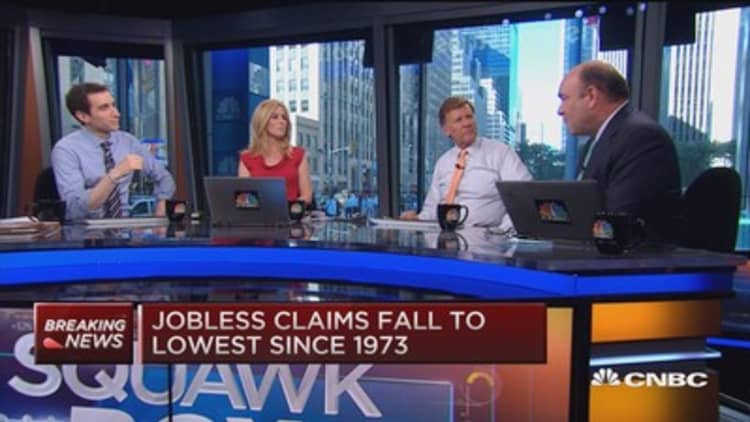
A near 42-year low in an economic reading as essential as weekly jobless claims is always going to get lots of investor attention.
This time, though, it should probably get a little less.
Thursday's release showing the number of new claims falling to 255,000 more likely was due to seasonal factors than it was to the job market turning some type of metaphorical corner. (Tweet This)
While the Department of Labor said there were "no special factors" causing the number to fall to its lowest level since Nov. 24, 1973, Wall Street experts disputed that notion. Economists believe multiple factors converged to provide such an unusually low reading.
"In July auto companies typically shut down facilities as they do some maintenance, and seasonal adjustments usually take this into account," Peter Boockvar, chief market analyst at The Lindsey Group, said in a note. "But if there is any shift by the auto companies in what they do, it can mess around with the seasonals. Thus, I don't want to read too much into the data."
A few other things to keep in mind: The four-week moving average, used to smooth out volatility in the numbers, is still at 278,500, down 4,000 from the previous week but still in the same ballpark. There's little reason, then, to think that the closely watched nonfarm payrolls data is poised for a breakout of its 250,000 monthly trend that it's found over the past year.
Another thing to keep in mind about history is that, viewed in a vacuum, it can distort things.
In this case, while weekly claims are at levels not seen since the Nixon administration, the labor force participation rate, which measures those considered actively in the group as a percent of the total population, was at 62.6 percent in June. That's the lowest since October 1977, or the early days of the Carter administration and an indicator of how much of a good news-bad news labor market this has become.
Read More Survey shows growing US shortage of skilled labor
Finally, the November 1973 period may have been a good one for workers, but it didn't last long. Claims shortly thereafter began to spike, hitting 575,000 on Jan. 18, 1975, as the unemployment rate went from 4.8 percent at the claims trough through 8.1 percent at the claims peak and up to 9 percent by May 1975.
So what's it all mean?
Investors are looking for a clue, any clue, to divine when the Federal Reserve might start raising rates. A one-week plunge in claims is unlikely to change the market's expectations, as measured in futures trading on the CBOE, for a December hike.
Read More Gundlach at Delivering Alpha: Fed's not hiking
Indeed, the market reacted little to Thursday's release, with stock indexes mixed as traders focused more on earnings and China than an economic data point aberration.
"When the dust clears in another week or two, look for the running rate to remain in that (275,000) vicinity that has prevailed much of the year," Stephen Stanley, chief economist of Amherst Pierpont Securities, said in a note. He added that the latest number "makes for a great headline, but the latest move is not worth getting very excited over."






